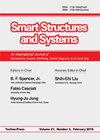基于无人机热成像和深度学习的建筑装饰层脱粘缺陷量化方法
IF 2.2
3区 工程技术
Q2 ENGINEERING, CIVIL
引用次数: 4
摘要
外墙建筑装饰层脱落现象十分普遍,尤其是在亚洲,这对人类安全和财产造成了极大的关注。目前,由于脱胶是一种隐藏的缺陷,没有有效的技术来检测外饰面的脱胶。本研究提出了一种通过无人机热成像和深度学习识别建筑装饰层脱胶缺陷的方法。首先,对脱胶缺陷的温度场特性进行了测试和分析,表明基于无人机识别BDL脱胶是可行的。然后,提出了一种结合CenterNet(点网络)和模糊聚类的去粘缺陷识别和量化方法。此外,通过光学成像原理使用实时测量的距离来量化脱胶缺陷的实际面积。最后,通过对老教学楼检测的实例分析,验证了该方法的有效性,表明该模型性能良好,准确率在90%以上,具有一定的社会实用价值。本文章由计算机程序翻译,如有差异,请以英文原文为准。
Debonding defect quantification method of building decoration layers via UAV-thermography and deep learning
The falling offs of building decorative layers (BDLs) on exterior walls are quite common, especially in Asia, which presents great concerns to human safety and properties. Presently, there is no effective technique to detect the debonding of the exterior finish because debonding are hidden defect. In this study, the debonding defect identification method of building decoration layers via UAV-thermography and deep learning is proposed. Firstly, the temperature field characteristics of debonding defects are tested and analyzed, showing that it is feasible to identify the debonding of BDLs based on UAV. Then, a debonding defect recognition and quantification method combining CenterNet (Point Network) and fuzzy clustering is proposed. Further, the actual area of debonding defect is quantified through the optical imaging principle using the real-time measured distance. Finally, a case study of the old teaching-building inspection is carried out to demonstrate the effectiveness of the proposed method, showing that the proposed model performs well with an accuracy above 90%, which is valuable to the society.
求助全文
通过发布文献求助,成功后即可免费获取论文全文。
去求助
来源期刊

Smart Structures and Systems
工程技术-工程:机械
CiteScore
6.50
自引率
8.60%
发文量
0
审稿时长
9 months
期刊介绍:
An International Journal of Mechatronics, Sensors, Monitoring, Control, Diagnosis, and Management airns at providing a major publication channel for researchers in the general area of smart structures and systems. Typical subjects considered by the journal include:
Sensors/Actuators(Materials/devices/ informatics/networking)
Structural Health Monitoring and Control
Diagnosis/Prognosis
Life Cycle Engineering(planning/design/ maintenance/renewal)
and related areas.
 求助内容:
求助内容: 应助结果提醒方式:
应助结果提醒方式:


